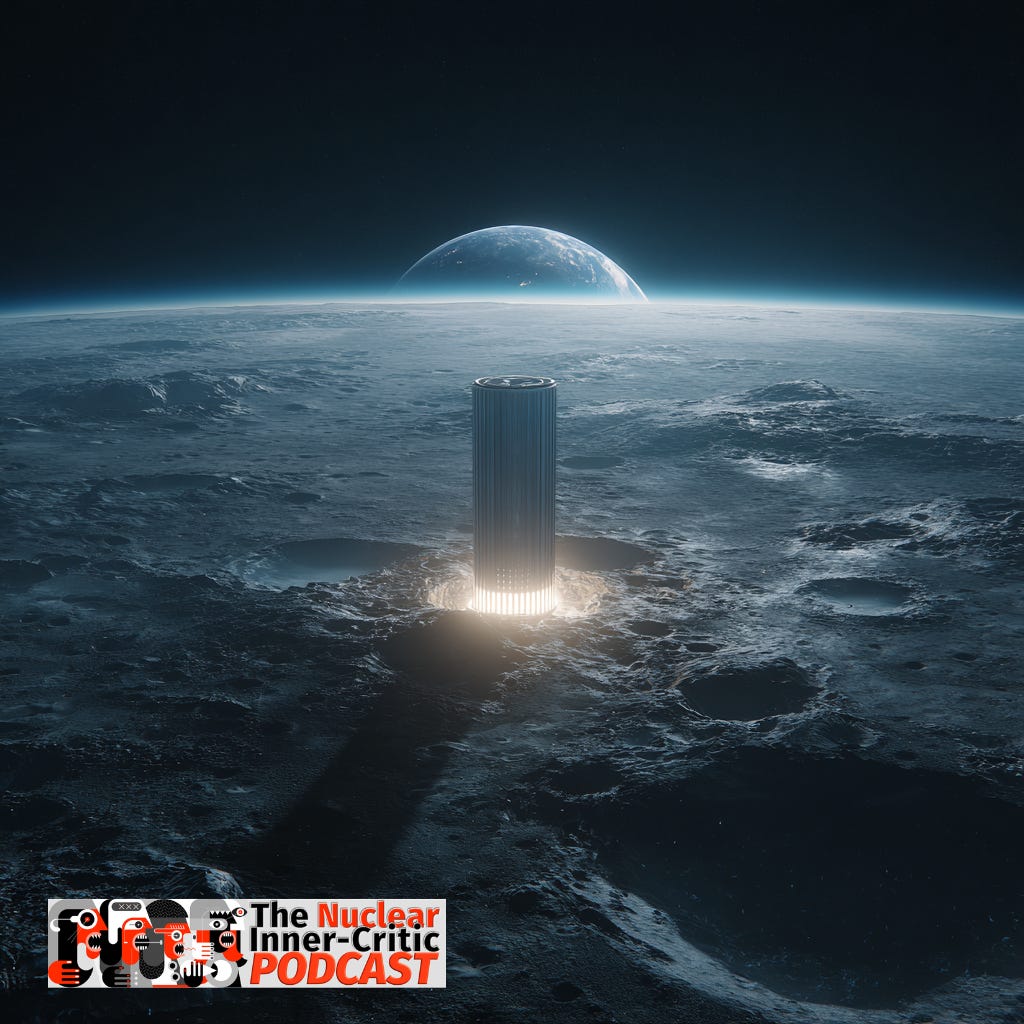When people in the nuclear industry talk about risk, they picture power plants, waste storage, and proliferation threats. But an entirely new contest is unfolding in near silence — a race to build the first nuclear reactor on the Moon, where power isn’t just electricity, its leverage, and territory can be claimed without calling it conquest.
NASA’s accelerated plan to install a 100-kilowatt fission reactor on the lunar surface by 2030 has been framed as a bold engineering challenge and a geopolitical necessity. The public conversation is dominated by the “race” aspect, who gets there first, the United States or China, and by visions of space exploration glory.
But missing almost entirely from industry discussions is the fact that lunar nuclear power is about to become an unregulated precedent factory—one that will influence safety norms, political boundaries, and operational practices for every terrestrial nuclear program in decades to come. The weakness is not technological; it’s institutional blind spots in governance, safety culture, and enforcement.
The 2030 Reactor Goal: From Science Project to Strategic Weapon
Under the direction of interim NASA Administrator Sean Duffy, the U.S. has shifted from exploratory talk to a concrete timeline: a fully functional lunar reactor by the end of this decade.
This is not your standard radioisotope thermoelectric generator running a rover on a few hundred watts. This is a full-scale fission reactor capable of powering habitats, mining operations, and industrial-scale 3D printing in an environment where nights last 14 Earth days and temperatures swing from searing heat to deep cryogenic cold.
Duffy’s push is explicitly framed as a race to secure strategic lunar territory, without calling it “territory,” before China and Russia can establish their own facilities. The logic is simple: whoever builds first can declare a “keep-out zone” on ‘safety’ grounds, effectively controlling access to resource-rich regions like the lunar south pole.
From a nuclear safety perspective, that means the very first operational lunar fission plant will set the informal global standard for design, deployment, and operational protocols—without the oversight mechanisms that have evolved over decades on Earth.
The Quiet Contest for Lunar Control
The space headlines talk about “historic milestones” and “renewed exploration,” but the reality is far more strategic. This is a race without cheering crowds, fought in design labs, policy briefings, and procurement contracts. The winner doesn’t just light up a habitat — they secure a position from which to shape the legal and operational norms of lunar industry.
If the first reactor comes with a broad exclusion zone justified as a safety measure, that zone becomes a de facto claim over nearby ice deposits, metal-rich regolith, or prime radio-silent terrain for telescopes. And because there’s no independent enforcement authority in space, “safety” will be defined entirely by the operator.
The Legal Mirage: Treaties That Look Strong But Act Weak
The 1967 Outer Space Treaty prohibits sovereign claims on celestial bodies and requires “due regard” for other nations’ activities. The 1992 UN Principles on the Use of Nuclear Power Sources in Outer Space set voluntary guidelines for safety, transparency, and consultation.
Voluntary.
On paper, these look like strong guardrails. In reality, they lack enforcement teeth. The first country to put a reactor on the Moon will have wide latitude in deciding how “safety” and “due regard” are interpreted.
This isn’t theoretical. Bhavya Lal, a former NASA technologist now at RAND, and Roger Myers, a veteran aerospace engineer and propulsion expert, have warned that a country could use “radiation safety” as a pretext to establish broad exclusion zones around a lunar reactor—effectively locking up nearby high-value sites.
On Earth, if a nuclear operator stretches safety justifications to cover a competitive advantage, regulators, watchdog NGOs, and the press can push back. On the Moon, who’s going to inspect? Who’s going to litigate? And perhaps most importantly, how will precedent set in that vacuum influence interpretations of “safety” back on Earth?
Safety Culture in a Vacuum (Literally)
From a technical standpoint, engineers know how to design a small, robust reactor for extreme environments. NASA and the Department of Energy have decades of experience with compact fission systems. The engineering risks — heat rejection without convection, regolith interference, radiation hardening — are real but solvable.
But the Moon introduces a safety culture hazard that’s barely discussed: the absence of an independent oversight ecosystem.
On Earth, nuclear operations are surrounded by regulators, insurers, emergency planners, and civil society. They provide friction—often frustrating to operators—but essential for catching blind spots.
On the Moon, there is no NRC, no IAEA inspectors, no local emergency responders, and no political opposition in the town hall. The operational culture will be shaped almost entirely by the priorities of the sponsoring agency and its contractors. And when the prime mission objective is geopolitical positioning, safety margins tend to erode at the edges.
In the worst case, the first lunar nuclear operations could normalize a single-actor, self-certified safety regime, and that’s a mindset that could creep back into Earthside nuclear development under the banner of “streamlining” or “innovation.”
The Precedent Spillover Problem
Why should terrestrial nuclear operators care what happens in a dusty crater 240,000 miles away? Because legal and cultural precedents travel.
If the U.S. successfully deploys a lunar reactor without multilaterally agreed inspection protocols, why shouldn’t another state claim the same exemption for a remote island SMR? If China gets away with defining a massive lunar “safety zone” to protect a reactor, what’s to stop them, or others, from using similar reasoning to cordon off ocean territories around floating nuclear plants?
The lunar reactor race is effectively a sandbox for redefining nuclear norms without terrestrial political pushback. Whatever works up there will be argued as acceptable down here.
Geopolitical Energy Lock-In
The strategic driver behind lunar nuclear power isn’t just keeping the lights on for astronauts; it’s controlling access to resources that could reshape space commerce:
Water ice in shadowed craters, convertible to rocket fuel and life support.
Rare metals like platinum and titanium for advanced manufacturing.
Radio-quiet zones on the far side, ideal for deep space radio astronomy.
Control of these requires constant, reliable power — something solar can’t deliver in two-week-long lunar nights. Nuclear is the only viable option, which means whoever masters it first doesn’t just win the Moon. They define the political and economic terms of the lunar industry.
This raises an awkward question for Earth’s nuclear community: are we prepared for nuclear technology to be the primary enabler of de facto territorial control in space? Because that’s not just a space policy issue; it’s a nuclear governance issue, and it’s happening now.
Environmental and Ethical Shadows
Proponents argue that a lunar reactor meltdown would be far less consequential than an Earthside one — no atmosphere to spread fallout, no biosphere to contaminate. That’s true in the immediate sense.
But there are longer-term ethical and environmental considerations:
Space debris contamination: Ejected radioactive particles could eventually migrate to cislunar space, where satellites operate.
Resource sterilization: Exclusion zones for safety could permanently block access to scientifically or economically important sites.
Reputation impact: A high-profile lunar nuclear failure could trigger public backlash against terrestrial nuclear programs, regardless of technical differences.
The nuclear industry is already fighting an uphill battle for public trust. A lunar accident — especially one perceived as the result of a rushed geopolitical race — could set back civilian nuclear deployment on Earth by decades.
What the Nuclear Industry Should Be Doing—Now
The space race narrative makes lunar nuclear power sound like an exotic, niche issue. It’s not. It’s a live-fire test of how nuclear safety, governance, and precedent-setting will work in places where our current frameworks can’t reach.
Here’s what should be on the nuclear industry’s agenda immediately:
Establish a Space Nuclear Safety Consortium
Bring together terrestrial nuclear regulators, IAEA experts, and aerospace engineers to create binding, inspection-capable safety protocols for extraterrestrial reactors.Push for Multilateral Inspection Rights
If you can’t have an NRC on the Moon, you can at least have an agreed multinational inspection team—before the first reactor is landed.Track Normative Creep
Assign policy teams to monitor how lunar safety justifications are being framed, so the industry can push back if they start being imported into terrestrial contexts where they don’t belong.Engage the Public Early
The first big lunar nuclear story the public hears shouldn’t be about a failure. Industry players should be helping to explain the safety case and the governance model now.
Conclusion: The Weakness No One is Watching
In the nuclear industry, we’re conditioned to think of risk in terms of materials, technology, and operations. But the greatest vulnerability in the lunar nuclear push isn’t in the reactor vessel; it’s in the governance vacuum around it.
Whoever wins the lunar reactor race will, by default, write the rulebook for off-world nuclear safety. And because there’s no enforcement mechanism, that rulebook will be whatever they say it is.
The lunar nuclear push isn’t just about exploration. It’s a silent race for power and territory, and the rules it writes may shape the nuclear industry on Earth for decades to come.
The Moon may be far away, but the precedents set there will come home fast.
The Nuclear Inner Critic Podcast is brought to you by:












